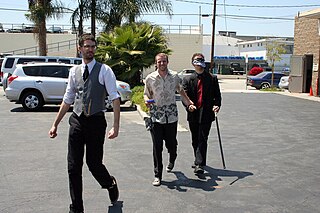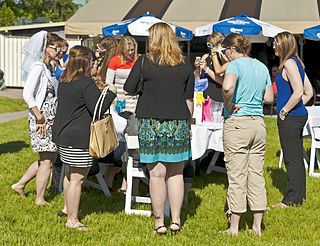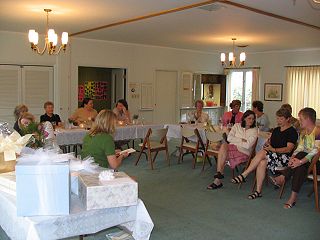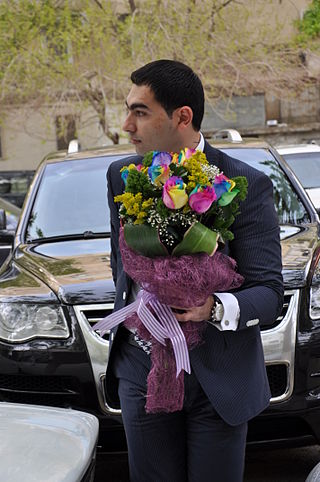
A wedding is a ceremony where two people are united in marriage. Wedding traditions and customs vary greatly between cultures, ethnic groups, races, religions, denominations, countries, social classes, and sexual orientations. Most wedding ceremonies involve an exchange of marriage vows by a couple, presentation of a gift, and a public proclamation of marriage by an authority figure or celebrant. Special wedding garments are often worn, and the ceremony is sometimes followed by a wedding reception. Music, poetry, prayers, or readings from religious texts or literature are also commonly incorporated into the ceremony, as well as superstitious customs.
A white wedding is a traditional formal or semi-formal wedding originating in Great Britain.

A wedding reception is a party usually held after the completion of a marriage ceremony as hospitality for those who have attended the wedding, hence the name reception: the couple receive society, in the form of family and friends, for the first time as a married couple. Hosts provide their choice of food and drink, although a wedding cake is popular.
Bridesmaids are members of the bride's party at some Western traditional wedding ceremonies. A bridesmaid is typically a young woman and often the bride's close friend or relative. She attends to the bride on the day of a wedding or marriage ceremony. Traditionally, bridesmaids were chosen from unwed young women of marriageable age.

A bachelor party, also known as a stag weekend, stag do or stag party, or a buck's night, is a party held/arranged by the man who is shortly to enter marriage.

A bachelorette party or hen night is a party held for a woman who will soon be married. While Beth Montemurro concludes that the bachelorette party is modelled after the centuries-old stag night in the US, which is itself historically a dinner given by the bridegroom to his friends shortly before his wedding, Sheila Young argues that its British counterpart evolved from a number of earlier pre-wedding traditions for women whose origins are obscure but which have been around for at least a century in factories and offices across the UK. Despite its reputation as "a sodden farewell to maiden days" or "an evening of debauchery", these events can simply be parties given in honor of the bride-to-be, in the style that is common to that social circle.

A bridal shower is a gift-giving party held for a bride-to-be in anticipation of her wedding.
The money dance, dollar dance, or apron dance is an event at some wedding receptions in various cultures. During a money dance, male guests pay to dance briefly with the bride, and sometimes female guests pay to dance with the groom.

The traditional Vietnamese wedding is one of the most important ceremonies in Vietnamese culture, which is influenced by Confucian and Buddhist ideologies.
Iranian wedding, also known as Persian wedding, consists of traditions rooted in Zoroastrianism, the primary religion of pre-Islamic Iran. Though the concepts and theories of marriage have been changed by Islamic traditions, the ceremonies have remained more or less the same as they were originally in pre-Islamic Iran. Although modern-day Iran is a multi-ethnic country, Iranian wedding traditions are embraced by the majority of ethnic groups in Iran.

Traditional Russian weddings can last between two days and one week. The celebration usually involves dancing, singing, toasting, and banqueting. The best man and bridesmaid are called "Witnesses" or "Свидетели" in Russian. The ceremony and the ring exchange take place on the first day of the wedding. Russian weddings ceremonies have undertaken a certain amount of Western traditions, including incorporating maids of honour into the wedding party.

An engagement party, also known as a betrothal party or fort, is a party held to celebrate a couple's recent engagement and to help future wedding guests to get to know one another. Traditionally, the bride's parents host the engagement party, but many modern couples host their own celebration.
Arabic weddings are ceremonies of matrimony that contain Arab influences or Arabic culture.
In the United States and Canada, weddings follow traditions often based on religion, culture, and social norms. Most wedding traditions in the United States and Canada were assimilated from other, generally European, countries. Marriages in the U.S. and Canada are typically arranged by the participants and ceremonies may either be religious or civil. There is a tradition that the prospective bridegroom ask his future father-in-law for his blessing.
"JK Wedding Entrance Dance" is a viral video originally uploaded to YouTube on July 19, 2009, featuring the wedding of Jill Peterson and Kevin Heinz, using "Forever" by Chris Brown as the song for their wedding march. In its first 48 hours, the video accumulated more than 3.5 million views. The original upload of the video was the third most popular video on YouTube in 2009, and as of July 2021 had been viewed over 100 million times. Time magazine ranked the video at number fifteen on its list of the fifty greatest YouTube videos.

Indian wedding clothes are elaborate set of clothes worn by the bride, bridegroom, and other relatives attending the wedding.

A bridegroom is a man who is about to be married or who is newlywed. In some circles, it is a modern alternative to bride or groom.

The Wedding Party is a 2016 Nigerian romantic comedy drama directed by Kemi Adetiba. It premiered on 8 September 2016 at the Toronto International Film Festival in Canada and on 26 November 2016 at Eko Hotel and Suites in Lagos. The film was released worldwide on 16 December 2016, and became the highest grossing Nigerian film; a record which was broken in 2021 by Omo Ghetto: The Saga.

The bedding ceremony refers to the wedding custom of putting the newlywed couple together in the marital bed in front of numerous witnesses, usually family, friends, and neighbors, thereby completing the marriage.














